20.1: Protestantism
20.1.1: Discontent with the Roman Catholic Church
The Protestant Reformation was the schism within Western Christianity initiated by Martin Luther, John Calvin, and other early Protestants.
Learning Objective
Explain the main motivating factors behind the Protestant Reformation
Key Points
- The Reformation began as an attempt to reform the Roman Catholic Church, by priests who opposed what they perceived as false doctrines and ecclesiastic malpractice.
- Following the breakdown of monastic institutions and scholasticism in late medieval Europe, accentuated by the Avignon Papacy, the Papal Schism, and the failure of the Conciliar movement, the 16th century saw a great cultural debate about religious reforms and later fundamental religious values. John Wycliffe and Jan Hus were early opponents of papal authority, and their work and views paved the way for the Reformation.
- Martin Luther was a seminal figure of the Protestant Reformation who strongly disputed the sale of indulgences. His Ninety-Five Theses criticized many of the doctrines and practices of the Catholic Church.
- The Roman Catholic Church responded with a Counter-Reformation spearheaded by the new order of the Society of Jesus (Jesuits), specifically organized to counter the Protestant movement.
Key Terms
- the Western Schism
-
A split within the Catholic Church from 1378 to 1418, when several men simultaneously claimed to be the true pope.
- Conciliar movement
-
A reform movement in the 14th-, 15th-, and 16th-century Catholic Church that held that supreme authority in the church resided with an Ecumenical council, apart from, or even against, the pope. The movement emerged in response to the Western Schism between rival popes in Rome and Avignon.
- indulgences
-
In Catholic theology, a remission of the punishment that would otherwise be inflicted for a previously forgiven sin as a natural consequence of having sinned. They are granted for specific good works and prayers in proportion to the devotion with which those good works are performed or prayers recited.
- Council of Trent
-
Council of the Roman Catholic Church set up in Trento, Italy, in direct response to the Reformation.
- ecclesiastic
-
One who adheres to a church-based philosophy.
- doctrine
-
List of beliefs and teachings by the church.
The Protestant Reformation, often referred to simply as the Reformation, was a schism from the Roman Catholic Church initiated by Martin Luther and continued by other early Protestant reformers in Europe in the 16th century.
Although there had been significant earlier attempts to reform the Roman Catholic Church before Luther—such as those of Jan Hus, Geert Groote, Thomas A Kempis, Peter Waldo, and John Wycliffe—Martin Luther is widely acknowledged to have started the Reformation with his 1517 work The Ninety-Five Theses.
Luther began by criticizing the selling of indulgences, insisting that the pope had no authority over purgatory and that the Catholic doctrine of the merits of the saints had no foundation in the gospel. The Protestant position, however, would come to incorporate doctrinal changes such as sola scriptura (by the scripture alone) and sola fide (by faith alone). The core motivation behind these changes was theological, though many other factors played a part, including the rise of nationalism, the Western Schism that eroded faith in the papacy, the perceived corruption of the Roman Curia, the impact of humanism, and the new learning of the Renaissance that questioned much traditional thought.
Roots of Unrest
Following the breakdown of monastic institutions and scholasticism in late medieval Europe, accentuated by the Avignon Papacy, the Papal Schism, and the failure of the Conciliar movement, the 16th century saw a great cultural debate about religious reforms and later fundamental religious values. These issues initiated wars between princes, uprisings among peasants, and widespread concern over corruption in the Church, which sparked many reform movement within the church.
These reformist movements occurred in conjunction with economic, political, and demographic forces that contributed to a growing disaffection with the wealth and power of the elite clergy, sensitizing the population to the financial and moral corruption of the secular Renaissance church.
The major individualistic reform movements that revolted against medieval scholasticism and the institutions that underpinned it were humanism, devotionalism, and the observantine tradition. In Germany, “the modern way,” or devotionalism, caught on in the universities, requiring a redefinition of God, who was no longer a rational governing principle but an arbitrary, unknowable will that could not be limited. God was now a ruler, and religion would be more fervent and emotional. Thus, the ensuing revival of Augustinian theology, stating that man cannot be saved by his own efforts but only by the grace of God, would erode the legitimacy of the rigid institutions of the church meant to provide a channel for man to do good works and get into heaven.
Humanism, however, was more of an educational reform movement with origins in the Renaissance’s revival of classical learning and thought. A revolt against Aristotelian logic, it placed great emphasis on reforming individuals through eloquence as opposed to reason. The European Renaissance laid the foundation for the Northern humanists in its reinforcement of the traditional use of Latin as the great unifying language of European culture. Since the breakdown of the philosophical foundations of scholasticism, the new nominalism did not bode well for an institutional church legitimized as an intermediary between man and God. New thinking favored the notion that no religious doctrine can be supported by philosophical arguments, eroding the old alliance between reason and faith of the medieval period laid out by Thomas Aquinas.
The great rise of the burghers (merchant class) and their desire to run their new businesses free of institutional barriers or outmoded cultural practices contributed to the appeal of humanist individualism. To many, papal institutions were rigid, especially regarding their views on just price and usury. In the north, burghers and monarchs were united in their frustration for not paying any taxes to the nation, but collecting taxes from subjects and sending the revenues disproportionately to the pope in Italy.
Early Attempts at Reform
The first of a series of disruptive and new perspectives came from John Wycliffe at Oxford University, one of the earliest opponents of papal authority influencing secular power and an early advocate for translation of the Bible into the common language. Jan Hus at the University of Prague was a follower of Wycliffe and similarly objected to some of the practices of the Roman Catholic Church. Hus wanted liturgy in the language of the people (i.e. Czech), married priests, and to eliminate indulgences and the idea of purgatory.
Hus spoke out against indulgences in 1412 when he delivered an address entitled Quaestio magistri Johannis Hus de indulgentiis. It was taken literally from the last chapter of Wycliffe’s book, De ecclesia, and his treatise, De absolutione a pena et culpa. Hus asserted that no pope or bishop had the right to take up the sword in the name of the Church; he should pray for his enemies and bless those that curse him; man obtains forgiveness of sins by true repentance, not money. The doctors of the theological faculty replied, but without success. A few days afterward, some of Hus’s followers burnt the papal bulls. Hus, they said, should be obeyed rather than the Church, which they considered a fraudulent mob of adulterers and Simonists.
In response, three men from the lower classes who openly called the indulgences a fraud were beheaded. They were later considered the first martyrs of the Hussite Church. In the meantime, the faculty had condemned the forty-five articles and added several other theses, deemed heretical, that had originated with Hus. The king forbade the teaching of these articles, but neither Hus nor the university complied with the ruling, requesting that the articles should first be proven to be un-scriptural. The tumults at Prague had stirred up a sensation; papal legates and Archbishop Albik tried to persuade Hus to give up his opposition to the papal bulls, and the king made an unsuccessful attempt to reconcile the two parties.
Hus was later condemned and burned at the stake despite promise of safe-conduct when he voiced his views to church leaders at the Council of Constance (1414–1418). Wycliffe, who died in 1384, was also declared a heretic by the Council of Constance, and his corpse was exhumed and burned.
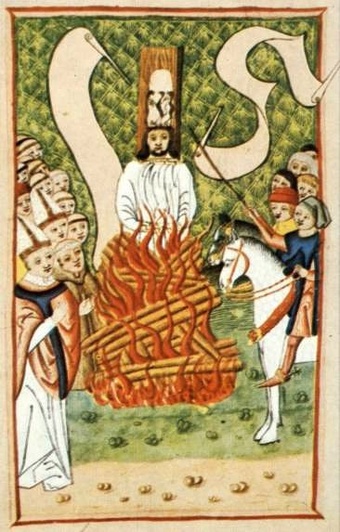
Jan Hus burned at the stake
Execution of Jan Hus at the Council of Constance in 1415. His death led to a radicalization of the Bohemian Reformation and to the Hussite Wars in the Crown of Bohemia.
The Creation of New Protestant Churches
The Reformation led to the creation of new national Protestant churches. The largest of the new church’s groupings were the Lutherans (mostly in Germany, the Baltics, and Scandinavia) and the Reformed churches (mostly in Germany, France, Switzerland, the Netherlands, and Scotland).
Response from the Catholic Church to the Reformation
The Roman Catholic Church responded with a Counter-Reformation initiated by the Council of Trent and spearheaded by the new order of the Society of Jesus (Jesuits), specifically organized to counter the Protestant movement. In general, Northern Europe, with the exception of most of Ireland, turned Protestant. Southern Europe remained Roman Catholic, while Central Europe was a site of fierce conflict escalating to full-scale war.
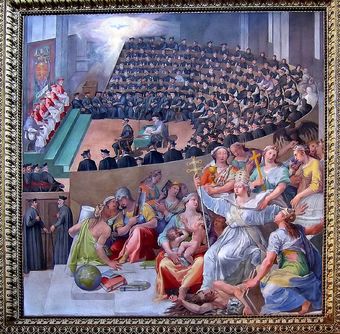
Council of Trent by Pasquale Cati
Painting representing the artist’s depiction of The Council of Trent. It met for twenty-five sessions between December 13, 1545, and December 4, 1563, in Trento (then the capital of the Prince-Bishopric of Trent in the Holy Roman Empire), apart from the ninth to eleventh sessions held in Bologna during 1547.
20.1.2: Luther and Protestantism
Martin Luther was a seminal figure in the Protestant Reformation; he strongly disputed the claim that freedom from God’s punishment for sin could be purchased with money, famously argued in his Ninety-five Theses of 1517.
Learning Objective
Describe Luther’s criticisms of the Catholic Church
Key Points
- Martin Luther was a German professor of theology, composer, priest, monk and seminal figure in the Protestant Reformation.
- Luther strongly disputed the claim that freedom from God’s punishment for sin could be purchased with money, called indulgences, which he argued in his Ninety-five Theses of 1517.
- When confronted by the church for his critiques, he refused to renounce his writings and was excommunicated by the pope and deemed an outlaw by the emperor.
- Luther’s translation of the Bible into the vernacular made it more accessible to the laity, an event that had a tremendous impact on both the church and German culture.
Key Terms
- Ninety-five Theses
-
A list of propositions for an academic disputation written by Martin Luther in 1517. They advanced Luther’s positions against what he saw as abusive practices by preachers selling plenary indulgences, which were certificates that would reduce the temporal punishment for sins committed by the purchaser or their loved ones in purgatory.
- excommunication
-
An institutional act of religious censure used to deprive, suspend, or limit membership in a religious community or to restrict certain rights within it.
- indulgences
-
A way to reduce the amount of punishment one has to undergo for sins, usually through the saying of prayers or good works, which during the middle ages included paying for church buildings or other projects.
Overview
Martin Luther (November 10, 1483–February 18, 1546) was a German professor of theology, composer, priest, monk and seminal figure in the Protestant Reformation. Luther came to reject several teachings and practices of the Roman Catholic Church. He strongly disputed the claim that freedom from God’s punishment for sin could be purchased with money, proposing an academic discussion of the practice and efficacy of indulgences in his Ninety-five Theses of 1517. His refusal to renounce all of his writings at the demand of Pope Leo X in 1520 and the Holy Roman Emperor Charles V at the Diet of Worms in 1521 resulted in his excommunication by the pope and condemnation as an outlaw by the emperor.
Luther taught that salvation and, subsequently, eternal life are not earned by good deeds but are received only as the free gift of God’s grace through the believer’s faith in Jesus Christ as redeemer from sin. His theology challenged the authority and office of the pope by teaching that the Bible is the only source of divinely revealed knowledge from God, and opposed priestly intervention for the forgiveness of sins by considering all baptized Christians to be a holy priesthood. Those who identify with these, and all of Luther’s wider teachings, are called Lutherans, though Luther insisted on Christian or Evangelical as the only acceptable names for individuals who professed Christ.
His translation of the Bible into the vernacular (instead of Latin) made it more accessible to the laity, an event that had a tremendous impact on both the church and German culture. It fostered the development of a standard version of the German language, added several principles to the art of translation, and influenced the writing of an English translation, the Tyndale Bible. His hymns influenced the development of singing in Protestant churches. His marriage to Katharina von Bora, a former nun, set a model for the practice of clerical marriage, allowing Protestant clergy to marry.
In two of his later works, Luther expressed antagonistic views toward Jews, writing that Jewish homes and synagogues should be destroyed, their money confiscated, and their liberty curtailed. Condemned by virtually every Lutheran denomination, these statements and their influence on antisemitism have contributed to his controversial status.
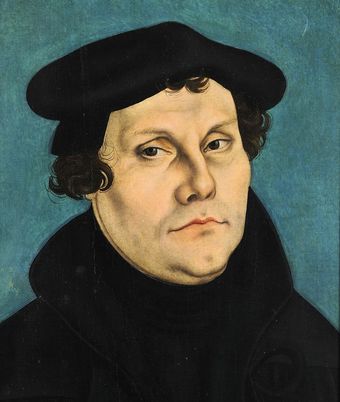
Portrait of Martin Luther
Martin Luther (1528) by Lucas Cranach the Elder.
Personal Life
Martin Luther was born to Hans Luther and his wife Margarethe on November 10, 1483, in Eisleben, Saxony, then part of the Holy Roman Empire. Hans Luther was ambitious for himself and his family, and he was determined to see Martin, his eldest son, become a lawyer.
In 1501, at the age of nineteen, Martin entered the University of Erfurt. In accordance with his father’s wishes, he enrolled in law school at the same university that year, but dropped out almost immediately, believing that law represented uncertainty. Luther sought assurances about life and was drawn to theology and philosophy, expressing particular interest in Aristotle, William of Ockham, and Gabriel Biel.
He was deeply influenced by two tutors, Bartholomaeus Arnoldi von Usingen and Jodocus Trutfetter, who taught him to be suspicious of even the greatest thinkers and to test everything himself by experience. Philosophy proved to be unsatisfying, offering assurance about the use of reason but no assurance about loving God, which to Luther was more important. Reason could not lead men to God, he felt, and he thereafter developed a love-hate relationship with Aristotle over the latter’s emphasis on reason. For Luther, reason could be used to question men and institutions, but not God. Human beings could learn about God only through divine revelation, he believed, and scripture therefore became increasingly important to him.
Luther dedicated himself to the Augustinian order, devoting himself to fasting, long hours in prayer, pilgrimage, and frequent confession. In 1507, he was ordained to the priesthood, and in 1508, von Staupitz, first dean of the newly founded University of Wittenberg, sent for Luther to teach theology. He was made provincial vicar of Saxony and Thuringia by his religious order in 1515. This meant he was to visit and oversee eleven monasteries in his province.
Start of the Reformation
In 1516, Johann Tetzel, a Dominican friar and papal commissioner for indulgences, was sent to Germany by the Roman Catholic Church to sell indulgences to raise money to rebuild St. Peter’s Basilica in Rome. Roman Catholic theology stated that faith alone, whether fiduciary or dogmatic, cannot justify man; justification rather depends only on such faith as is active in charity and good works. The benefits of good works could be obtained by donating money to the church.
On October 31, 1517, Luther wrote to his bishop, Albert of Mainz, protesting the sale of indulgences. He enclosed in his letter a copy of his “Disputation of Martin Luther on the Power and Efficacy of Indulgences,” which came to be known as the Ninety-five Theses. Historian Hans Hillerbrand writes that Luther had no intention of confronting the church, but saw his disputation as a scholarly objection to church practices, and the tone of the writing is accordingly “searching, rather than doctrinaire.” Hillerbrand writes that there is nevertheless an undercurrent of challenge in several of the theses, particularly in Thesis 86, which asks, “Why does the pope, whose wealth today is greater than the wealth of the richest Crassus, build the basilica of St. Peter with the money of poor believers rather than with his own money?”
The first thesis has become famous: “When our Lord and Master Jesus Christ said, ‘Repent,’ he willed the entire life of believers to be one of repentance.” In the first few theses Luther develops the idea of repentance as the Christian’s inner struggle with sin rather than the external system of sacramental confession.
In theses 41–47 Luther begins to criticize indulgences on the basis that they discourage works of mercy by those who purchase them. Here he begins to use the phrase, “Christians are to be taught…” to state how he thinks people should be instructed on the value of indulgences. They should be taught that giving to the poor is incomparably more important than buying indulgences, that buying an indulgence rather than giving to the poor invites God’s wrath, and that doing good works makes a person better while buying indulgences does not.
Luther objected to a saying attributed to Johann Tetzel that “As soon as the coin in the coffer rings, the soul from purgatory springs.” He insisted that, since forgiveness was God’s alone to grant, those who claimed that indulgences absolved buyers from all punishments and granted them salvation were in error. Luther closes the Theses by exhorting Christians to imitate Christ even if it brings pain and suffering, because enduring punishment and entering heaven is preferable to false security.
It was not until January 1518 that friends of Luther translated the Ninety-five Theses from Latin into German and printed and widely copied it, making the controversy one of the first to be aided by the printing press. Within two weeks, copies of the theses had spread throughout Germany; within two months, they had spread throughout Europe.
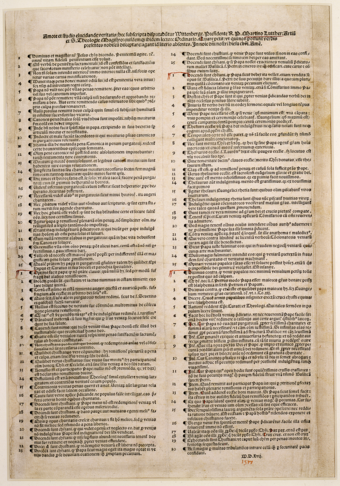
Ninety-five Theses
1517 Nuremberg printing of the Ninety-five Theses as a placard, now in the Berlin State Library.
Excommunication and Later Life
On June 15, 1520, the pope warned Luther, with the papal bull Exsurge Domine, that he risked excommunication unless he recanted forty-one sentences drawn from his writings, including the Ninety-five Theses, within sixty days. That autumn, Johann Eck proclaimed the bull in Meissen and other towns. Karl von Miltitz, a papal nuncio, attempted to broker a solution, but Luther, who had sent the pope a copy of On the Freedom of a Christian in October, publicly set fire to the bull and decretals at Wittenberg on December 10, 1520, an act he defended in Why the Pope and his Recent Book are Burned and Assertions Concerning All Articles. As a consequence, Luther was excommunicated by Pope Leo X on January 3, 1521, in the bull Decet Romanum Pontificem.
The enforcement of the ban on the Ninety-five Theses fell to the secular authorities. On April 18, 1521, Luther appeared as ordered before the Diet of Worms. This was a general assembly of the estates of the Holy Roman Empire that took place in Worms, a town on the Rhine. It was conducted from January 28 to May 25, 1521, with Emperor Charles V presiding. Prince Frederick III, Elector of Saxony, obtained a safe conduct for Luther to and from the meeting.
Johann Eck, speaking on behalf of the empire as assistant of the Archbishop of Trier, presented Luther with copies of his writings laid out on a table and asked him if the books were his, and whether he stood by their contents. Luther confirmed he was their author, but requested time to think about the answer to the second question. He prayed, consulted friends, and gave his response the next day:
Unless I am convinced by the testimony of the Scriptures or by clear reason (for I do not trust either in the pope or in councils alone, since it is well known that they have often erred and contradicted themselves), I am bound by the Scriptures I have quoted and my conscience is captive to the Word of God. I cannot and will not recant anything, since it is neither safe nor right to go against conscience. May God help me. Amen.
Over the next five days, private conferences were held to determine Luther’s fate. The emperor presented the final draft of the Edict of Worms on May 25, 1521, which declared Luther an outlaw, banned his literature, and required his arrest: “We want him to be apprehended and punished as a notorious heretic.” It also made it a crime for anyone in Germany to give Luther food or shelter, and permitted anyone to kill Luther without legal consequence.
By 1526, Luther found himself increasingly occupied in organizing a new church, later called the Lutheran Church, and for the rest of his life would continue building the Protestant movement.
An apoplectic stroke on February 18, 1546, deprived him of his speech, and he died shortly afterwards, at 2:45 a.m., aged sixty-two, in Eisleben, the city of his birth. He was buried in the Castle Church in Wittenberg, beneath the pulpit.
20.1.3: Calvinism
Calvinism is a major branch of Protestantism that follows the theological tradition and forms of Christian practice of John Calvin and is characterized by the doctrine of predestination in the salvation of souls.
Learning Objective
Compare and contrast Calvinism with Lutheranism
Key Points
- Calvinism is a major branch of Protestantism that follows the theological tradition and forms of Christian practice of John Calvin and other Reformation-era theologians.
- Calvin’s theological critiques mostly broke with the Roman Catholic Church, but he differed from Luther on certain theological points, such as the idea that Christ died only for the elect instead of all humanity, like Luther believed.
- Calvin’s “Ordinances” of 1541 involved a collaboration of church affairs with the Geneva city council and consistory to bring morality to all areas of life. Geneva became the center of Protestantism.
- Protestantism also spread into France, where the Protestants were derisively nicknamed “Huguenots,” and this touched off decades of warfare in France.
- Calvin’s Institutes of the Christian Religion (1536–1559) was one of the most influential theologies of the era and was written as an introductory textbook on the Protestant faith.
Key Terms
- predestination
-
The doctrine that all events have been willed by God, usually with reference to the eventual fate of the individual soul.
- Five Points of Calvinism
-
The basic theological tenets of Calvinism.
- Huguenots
-
A name for French Protestants, originally a derisive term.
Overview
Calvinism is a major branch of Protestantism that follows the theological tradition and forms of Christian practice of John Calvin and other Reformation-era theologians.
Calvinists broke with the Roman Catholic Church but differed from Lutherans on the real presence of Christ in the Eucharist, theories of worship, and the use of God’s law for believers, among other things. Calvinism can be a misleading term because the religious tradition it denotes is and has always been diverse, with a wide range of influences rather than a single founder. The movement was first called Calvinism by Lutherans who opposed it, and many within the tradition would prefer to use the word Reformed. While the Reformed theological tradition addresses all of the traditional topics of Christian theology, the word Calvinism is sometimes used to refer to particular Calvinist views on soteriology (the saving of the soul from sin and death) and predestination, which are summarized in part by the Five Points of Calvinism. Some have also argued that Calvinism as a whole stresses the sovereignty or rule of God in all things, including salvation. An important tenet of Calvinism, which differs from Lutheranism, is that God only saves the “elect,” a predestined group of individuals, and that these elect are essentially guaranteed salvation, but everyone else is damned.
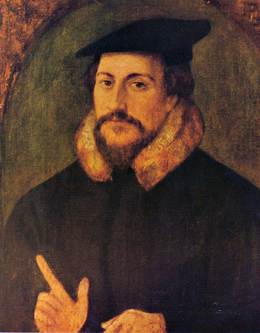
John Calvin
A portrait of John Calvin, one of the major figures in the Protestant Reformation, by Holbein.
Origins and Rise of Calvinism
First-generation Reformed theologians include Huldrych Zwingli (1484–1531), Martin Bucer (1491–1551), Wolfgang Capito (1478–1541), John Oecolampadius (1482–1531), and Guillaume Farel (1489–1565). These reformers came from diverse academic backgrounds, but later distinctions within Reformed theology can already be detected in their thought, especially the priority of scripture as a source of authority. Scripture was also viewed as a unified whole, which led to a covenantal theology of the sacraments of baptism and the Lord’s Supper as visible signs of the covenant of grace. Another Reformed distinctive present in these theologians was their denial of the bodily presence of Christ in the Lord’s Supper. Each of these theologians also understood salvation to be by grace alone, and affirmed a doctrine of particular election (the teaching that some people are chosen by God for salvation). Martin Luther and his successor Philipp Melanchthon were undoubtedly significant influences on these theologians, and to a larger extent later Reformed theologians. The doctrine of justification by faith alone was a direct inheritance from Luther.
Following the excommunication of Luther and condemnation of the Reformation by the pope, the work and writings of John Calvin were influential in establishing a loose consensus among various groups in Switzerland, Scotland, Hungary, Germany, and elsewhere. After the expulsion of Geneva’s bishop in 1526, and the unsuccessful attempts of the Berne reformer Guillaume (William) Farel, Calvin was asked to use the organizational skill he had gathered as a student of law to discipline the “fallen city.” His “Ordinances” of 1541 involved a collaboration of church affairs with the city council and consistory to bring morality to all areas of life. After the establishment of the Geneva academy in 1559, Geneva became the unofficial capital of the Protestant movement, providing refuge for Protestant exiles from all over Europe and educating them as Calvinist missionaries. These missionaries dispersed Calvinism widely, and formed the French Huguenots in Calvin’s own lifetime, as well as caused the conversion of Scotland under the leadership of the cantankerous John Knox in 1560. The faith continued to spread after Calvin’s death in 1563, and had reached as far as Constantinople by the start of the 17th century.
Calvin’s Institutes of the Christian Religion (1536–1559) was one of the most influential theologies of the era. The book was written as an introductory textbook on the Protestant faith for those with some previous knowledge of theology, and covered a broad range of theological topics, from the doctrines of church and sacraments to justification by faith alone and Christian liberty. It vigorously attacked the teachings Calvin considered unorthodox, particularly Roman Catholicism, to which Calvin says he had been “strongly devoted” before his conversion to Protestantism.
Controversies in France
Protestantism spread into France, where the Protestants were derisively nicknamed “Huguenots,” and this touched off decades of warfare in France, after initial support by Henry of Navarre was lost due to the “Night of the Placards” affair. Many French Huguenots, however, still contributed to the Protestant movement, including many who emigrated to the English colonies.
Though he was not personally interested in religious reform, Francis I (1515–1547) initially maintained an attitude of tolerance arising from his interest in the humanist movement. This changed in 1534 with the Affair of the Placards. In this act, Protestants denounced the mass in placards that appeared across France, even reaching the royal apartments. The issue of religious faith having been thrown into the arena of politics, Francis was prompted to view the movement as a threat to the kingdom’s stability. This led to the first major phase of anti-Protestant persecution in France, in which the Chambre Ardente (“Burning Chamber”) was established within the Parliament of Paris to handle the rise in prosecutions for heresy. Several thousand French Protestants fled the country during this time, most notably John Calvin, who settled in Geneva.
Calvin continued to take an interest in the religious affairs of his native land and, from his base in Geneva, beyond the reach of the French king, regularly trained pastors to lead congregations in France. Despite heavy persecution by Henry II, the Reformed Church of France, largely Calvinist in direction, made steady progress across large sections of the nation, in the urban bourgeoisie and parts of the aristocracy, appealing to people alienated by the obduracy and the complacency of the Catholic establishment.
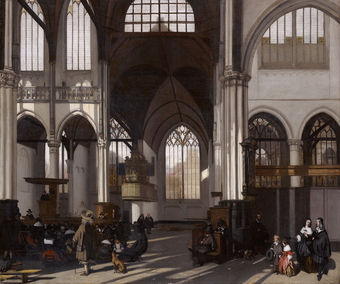
Interior of a Calvinist Church
Calvinism has been known at times for its simple, unadorned churches and lifestyles, as depicted in this painting by Emanuel de Witte c.1661.
Calvinist Theology
The “Five Points of Calvinism” summarize the faith’s basic tenets, although some historians contend that it distorts the nuance of Calvin’s own theological positions.
The Five Points:
- “Total depravity” asserts that as a consequence of the fall of man into sin, every person is enslaved to sin. People are not by nature inclined to love God, but rather to serve their own interests and to reject the rule of God. Thus, all people by their own faculties are morally unable to choose to follow God and be saved because they are unwilling to do so out of the necessity of their own natures.
- “Unconditional election” asserts that God has chosen from eternity those whom he will bring to himself not based on foreseen virtue, merit, or faith in those people; rather, his choice is unconditionally grounded in his mercy alone. God has chosen from eternity to extend mercy to those he has chosen and to withhold mercy from those not chosen. Those chosen receive salvation through Christ alone. Those not chosen receive the just wrath that is warranted for their sins against God.
- “Limited atonement” asserts that Jesus’s substitutionary atonement was definite and certain in its purpose and in what it accomplished. This implies that only the sins of the elect were atoned for by Jesus’s death. Calvinists do not believe, however, that the atonement is limited in its value or power, but rather that the atonement is limited in the sense that it is intended for some and not all. All Calvinists would affirm that the blood of Christ was sufficient to pay for every single human being IF it were God’s intention to save every single human being.
- “Irresistible grace” asserts that the saving grace of God is effectually applied to those whom he has determined to save (that is, the elect) and overcomes their resistance to obeying the call of the gospel, bringing them to a saving faith. This means that when God sovereignly purposes to save someone, that individual certainly will be saved. The doctrine holds that this purposeful influence of God’s Holy Spirit cannot be resisted.
- “Perseverance of the saints” asserts that since God is sovereign and his will cannot be frustrated by humans or anything else, those whom God has called into communion with himself will continue in faith until the end.
20.1.4: The Anabaptists
The Anabaptists were a group of radical religious reformists formed in Switzerland who suffered violent persecution by both Roman Catholics and Protestants.
Learning Objective
Explain why the Anabaptists were ostracized by much of Europe
Key Points
- Anabaptists are Christians who believe in delaying baptism until the candidate confesses his or her faith in Christ, as opposed to being baptized as an infant.
- Anabaptists were heavily persecuted during the 16th century and into the 17th century by both Protestants and Roman Catholics, including being drowned and burned at the stake.
- Anabaptists were often in conflict with civil society because part of their belief was to follow scripture at all costs, no matter the wishes of secular authority.
- Continuing persecution in Europe was largely responsible for the mass emigrations to North America by Amish, Hutterites, and Mennonites, some of the major branches of Anabaptists.
Key Terms
- Magisterial Protestants
-
A phrase that names the manner in which the Lutheran and Calvinist reformers related to secular authorities, such as princes, magistrates, or city councils; opposed to the Radical Protestants.
- infant baptism
-
The practice of baptizing infants or young children, sometimes contrasted with what is called “believer’s baptism,” which is the religious practice of baptizing only individuals who personally confess faith in Jesus.
- Ulrich Zwingli
-
A leader of the Reformation in Switzerland who clashed with the Anabaptists.
Overview
Anabaptism is a Christian movement that traces its origins to the Radical Reformation in Europe. Some consider this movement to be an offshoot of European Protestantism, while others see it as distinct.
Anabaptists are Christians who believe in delaying baptism until the candidate confesses his or her faith in Christ, as opposed to being baptized as an infant. The Amish, Hutterites, and Mennonites are direct descendants of the movement. Schwarzenau Brethren, Bruderhof, and the Apostolic Christian Church are considered later developments among the Anabaptists.
The name Anabaptist means “one who baptizes again.” Their persecutors named them this, referring to the practice of baptizing persons when they converted or declared their faith in Christ, even if they had been “baptized” as infants. Anabaptists required that baptismal candidates be able to make a confession of faith that was freely chosen, and so rejected baptism of infants. The early members of this movement did not accept the name Anabaptist, claiming that infant baptism was not part of scripture and was therefore null and void. They said that baptizing self-confessed believers was their first true baptism. Balthasar Hubmaier wrote:
I have never taught Anabaptism…But the right baptism of Christ, which is preceded by teaching and oral confession of faith, I teach, and say that infant baptism is a robbery of the right baptism of Christ.
Anabaptists were heavily persecuted during the 16th century and into the 17th century because of their views on the nature of baptism and other issues, by both Magisterial Protestants and Roman Catholics.
Anabaptists were persecuted largely because of their interpretation of scripture that put them at odds with official state church interpretations and government. Most Anabaptists adhered to a literal interpretation of the Sermon on the Mount, which precluded taking oaths, participating in military actions, and participating in civil government. Some who practiced re-baptism, however, felt otherwise, and complied with these requirements of civil society. They were thus technically Anabaptists, even though conservative Amish, Mennonites, and Hutterites, and some historians, tend to consider them as outside of true Anabaptism.
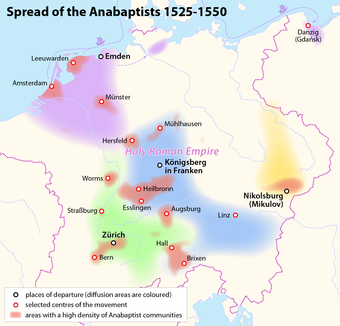
Spread of the Anabaptists 1525–1550 in Central Europe
After starting in Switzerland, Anabaptism spread to Tyrol (modern-day Austria), South Germany, Moravia, the Netherlands, and Belgium.
Origins
Anabaptism in Switzerland began as an offshoot of the church reforms instigated by Ulrich Zwingli. As early as 1522 it became evident that Zwingli was on a path of reform preaching when he began to question or criticize such Catholic practices as tithes, the mass, and even infant baptism. Zwingli had gathered a group of reform-minded men around him, with whom he studied classical literature and the scriptures. However, some of these young men began to feel that Zwingli was not moving fast enough in his reform. The division between Zwingli and his more radical disciples became apparent in an October 1523 disputation held in Zurich. When the discussion of the mass was about to be ended without making any actual change in practice, Conrad Grebel stood up and asked “what should be done about the mass?” Zwingli responded by saying the council would make that decision. At this point, Simon Stumpf, a radical priest from Hongg, answered, saying, “The decision has already been made by the Spirit of God.”
This incident illustrated clearly that Zwingli and his more radical disciples had different expectations. To Zwingli, the reforms would only go as fast as the city council allowed them. To the radicals, the council had no right to make that decision, but rather the Bible was the final authority on church reform. Feeling frustrated, some of them began to meet on their own for Bible study. As early as 1523, William Reublin began to preach against infant baptism in villages surrounding Zurich, encouraging parents to not baptize their children.
The council ruled in this meeting that all who refused to baptize their infants within one week should be expelled from Zurich. Since Conrad Grebel had refused to baptize his daughter Rachel, born on January 5, 1525, the council decision was extremely personal to him and others who had not baptized their children. Thus, when sixteen of the radicals met on Saturday evening, January 21, 1525, the situation seemed particularly dark.
At that meeting Grebel baptized George Blaurock, and Blaurock in turn baptized several others immediately. These baptisms were the first “re-baptisms” known in the movement. This continues to be the most widely accepted date posited for the establishment of Anabaptism.
Anabaptism then spread to Tyrol (modern-day Austria), South Germany, Moravia, the Netherlands, and Belgium.
Persecutions
Roman Catholics and Protestants alike persecuted the Anabaptists, resorting to torture and execution in attempts to curb the growth of the movement. The Protestants under Zwingli were the first to persecute the Anabaptists, with Felix Manz becoming the first martyr in 1527. On May 20, 1527, Roman Catholic authorities executed Michael Sattler. King Ferdinand declared drowning (called the third baptism) “the best antidote to Anabaptism.” The Tudor regime, even the Protestant monarchs (Edward VI of England and Elizabeth I of England), persecuted Anabaptists, as they were deemed too radical and therefore a danger to religious stability. The persecution of Anabaptists was condoned by ancient laws of Theodosius I and Justinian I that were passed against the Donatists, which decreed the death penalty for any who practiced re-baptism. Martyrs Mirror, by Thieleman J. van Braght, describes the persecution and execution of thousands of Anabaptists in various parts of Europe between 1525 and 1660. Continuing persecution in Europe was largely responsible for the mass emigrations to North America by Amish, Hutterites, and Mennonites.
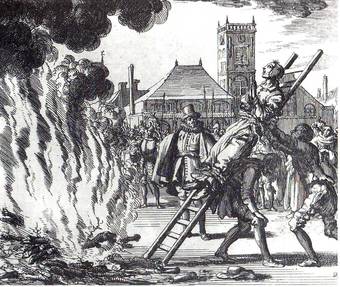
Burning of an Anabaptist
The burning of a 16th-century Dutch Anabaptist, Anneken Hendriks, who was charged by the Spanish Inquisition with heresy.
20.1.5: The Anglican Church
Beginning with Henry VIII in the 16th century, the Church of England broke away from the authority of the pope and the Catholic Church.
Learning Objective
Describe the key developments of the English Reformation, distinguishing it from the wider reformation movement in Europe.
Key Points
- The English Reformation was associated with the wider process of the European Protestant Reformation, though based on Henry VIII’s desire for an annulment of his marriage, it was at the outset more of a political affair than a theological dispute.
- Having been refused an annulment by the pope, Henry summoned parliament to deal with annulment, and the breaking with Rome proceeded.
- After Henry’s death his son Edward VI was crowned, and the reformation continued with the destruction and removal of decor and religious features, which changed the church forever.
- From 1553, under the reign of Henry’s Roman Catholic daughter, Mary I, the Reformation legislation was repealed, and Mary sought to achieve reunion with Rome.
- During Elizabeth I’s reign, support for her father’s idea of reforming the church continued with some minor adjustments. In this way, Elizabeth and her advisors aimed at a church that found a middle ground.
Key Terms
- Puritans
-
Group of English Protestants in the 16th and 17th centuries founded by some exiles from the clergy shortly after the accession of Elizabeth I of England.
- annulment
-
Legal term for declaring a marriage null and void. Unlike divorce, it is usually retroactive, meaning that this kind of marriage is considered to be invalid from the beginning, almost as if it had never taken place. They are closely associated with the Catholic Church, which does not permit divorce, teaching that marriage is a lifelong commitment that cannot be dissolved through divorce.
- nationalism
-
A belief, creed, or political ideology that involves an individual identifying with, or becoming attached to, one’s nation. In Europe, people were generally loyal to the church or to a local king or leader.
- Canon Law
-
The body of laws and regulations made by ecclesiastical authority (church leadership), for the government of a Christian organization or church and its members.
Overview
The English Reformation was a series of events in 16th-century England by which the Church of England broke away from the authority of the pope and the Roman Catholic Church. The English Reformation was, in part, associated with the wider process of the European Protestant Reformation, a religious and political movement that affected the practice of Christianity across most of Europe during this period. Many factors contributed to the process—the decline of feudalism and the rise of nationalism, the rise of the common law, the invention of the printing press and increased circulation of the Bible, and the transmission of new knowledge and ideas among scholars, the upper and middle classes, and readers in general. However, the various phases of the English Reformation, which also covered Wales and Ireland, were largely driven by changes in government policy, to which public opinion gradually accommodated itself.
Role of Henry VIII and Royal Marriages
Henry VIII ascended the English throne in 1509 at the age of seventeen. He made a dynastic marriage with Catherine of Aragon, widow of his brother, Arthur, in June 1509, just before his coronation on Midsummer’s Day. Unlike his father, who was secretive and conservative, the young Henry appeared the epitome of chivalry and sociability. An observant Roman Catholic, he heard up to five masses a day (except during the hunting season). Of “powerful but unoriginal mind,” he let himself be influenced by his advisors from whom he was never apart, by night or day. He was thus susceptible to whoever had his ear.
This contributed to a state of hostility between his young contemporaries and the Lord Chancellor, Cardinal Thomas Wolsey. As long as Wolsey had his ear, Henry’s Roman Catholicism was secure; in 1521, he defended the Roman Catholic Church from Martin Luther’s accusations of heresy in a book he wrote—probably with considerable help from the conservative Bishop of Rochester, John Fisher—entitled The Defence of the Seven Sacraments, for which he was awarded the title “Defender of the Faith” by Pope Leo X. Wolsey’s enemies at court included those who had been influenced by Lutheran ideas, among whom was the attractive, charismatic Anne Boleyn.
Anne arrived at court in 1522 from years in France, where she had been educated by Queen Claude of France. Anne served as maid of honor to Queen Catherine. She was a woman of “charm, style and wit, with will and savagery which made her a match for Henry.” By the late 1520s, Henry wanted his marriage to Catherine annulled. She had not produced a male heir who survived into adulthood, and Henry wanted a son to secure the Tudor dynasty.
Henry claimed that this lack of a male heir was because his marriage was “blighted in the eyes of God”; Catherine had been his late brother’s wife, and it was therefore against biblical teachings for Henry to have married her—a special dispensation from Pope Julius II had been needed to allow the wedding to take place. Henry argued that this had been wrong and that his marriage had never been valid. In 1527 Henry asked Pope Clement VII to annul the marriage, but the pope refused. According to Canon Law the pope cannot annul a marriage on the basis of a canonical impediment previously dispensed. Clement also feared the wrath of Catherine’s nephew, Holy Roman Emperor Charles V, whose troops earlier that year had sacked Rome and briefly taken the pope prisoner.
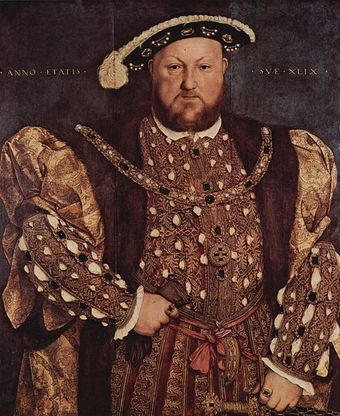
Portrait of Henry VIII (1491–1547)
Portrait by Hans Holbein the Younger, 1539–1540.
In 1529 the king summoned parliament to deal with annulment, thus bringing together those who wanted reform but disagreed what form it should take; it became known as the Reformation Parliament. There were common lawyers who resented the privileges of the clergy to summon laity to their courts, and there were those who had been influenced by Lutheran evangelicalism and were hostile to the theology of Rome; Thomas Cromwell was both.
Cromwell was a lawyer and a member of Parliament—a Protestant who saw how Parliament could be used to advance the Royal Supremacy, which Henry wanted, and to further Protestant beliefs and practices Cromwell and his friends wanted.
The breaking of the power of Rome proceeded little by little starting in 1531. The Act in Restraint of Appeals, drafted by Cromwell, declared that clergy recognized Henry as the “sole protector and Supreme Head of the Church and clergy of England.” This declared England an independent country in every respect.
Meanwhile, having taken Anne to France on a pre-nuptial honeymoon, Henry married her in Westminster Abbey in January 1533.
Henry maintained a strong preference for traditional Catholic practices and, during his reign, Protestant reformers were unable to make many changes to the practices of the Church of England. Indeed, this part of Henry’s reign saw trials for heresy of Protestants as well as Roman Catholics.
The Reformation during Edward VI
When Henry died in 1547, his nine-year-old son, Edward VI, inherited the throne. Under King Edward VI, more Protestant-influenced forms of worship were adopted. Under the leadership of the Archbishop of Canterbury, Thomas Cranmer, a more radical reformation proceeded. Cranmer introduced a series of religious reforms that revolutionized the English church from one that—while rejecting papal supremacy—remained essentially Catholic to one that was institutionally Protestant. All images in churches were to be dismantled. Stained glass, shrines, and statues were defaced or destroyed. Roods, and often their lofts and screens, were cut down and bells were taken down. Vestments were prohibited and either burned or sold. Chalices were melted down or sold. The requirement of the clergy to be celibate was lifted. Processions were banned and ashes and palms were prohibited.
A new pattern of worship was set out in the Book of Common Prayer (1549 and 1552). These were based on the older liturgy but influenced by Protestant principles. Cranmer’s formulation of the reformed religion, finally divesting the communion service of any notion of the real presence of God in the bread and the wine, effectively abolished the mass. The publication of Cranmer’s revised prayer book in 1552, supported by a second Act of Uniformity, “marked the arrival of the English Church at protestantism.” The prayer book of 1552 remains the foundation of the Church of England’s services. However, Cranmer was unable to implement all these reforms once it became clear in the spring of 1553 that King Edward, upon whom the whole Reformation in England depended, was dying.
Catholic Restoration
From 1553, under the reign of Henry’s Roman Catholic daughter, Mary I, the Reformation legislation was repealed, and Mary sought to achieve reunion with Rome. Her first Act of Parliament was to retroactively validate Henry’s marriage to her mother and so legitimize her claim to the throne.
After 1555, the initial reconciling tone of the regime began to harden. The medieval heresy laws were restored and 283 Protestants were burned at the stake for heresy. Full restoration of the Catholic faith in England to its pre-Reformation state would take time. Consequently, Protestants secretly ministering to underground congregations were planning for a long haul, a ministry of survival. However, Mary died in November 1558, childless and without having made provision for a Catholic to succeed her, undoing her work to restore the Catholic Church in England.
Elizabeth I
Following Mary’s death, her half-sister Elizabeth inherited the throne. One of the most important concerns during Elizabeth’s early reign was religion. Elizabeth could not be Catholic, as that church considered her illegitimate, being born of Anne Boleyn. At the same time, she had observed the turmoil brought about by Edward’s introduction of radical Protestant reforms. Communion with the Catholic Church was again severed by Elizabeth. Chiefly she supported her father’s idea of reforming the church, but she made some minor adjustments. In this way, Elizabeth and her advisors aimed at a church that included most opinions.
Two groups were excluded in Elizabeth’s Church of England. Roman Catholics who remained loyal to the pope were not tolerated. They were, in fact, regarded as traitors because the pope had refused to accept Elizabeth as Queen of England. Roman Catholics were given the hard choice of being loyal either to their church or their country. For some priests it meant life on the run, and in some cases death for treason.
The other group not tolerated were people who wanted reform to go much further, and who finally gave up on the Church of England. They could no longer see it as a true church. They believed it had refused to obey the Bible, so they formed small groups of convinced believers outside the church. One of the main groups that formed during this time was the Puritans. The government responded with imprisonment and exile to try to crush these “separatists.”
20.1.6: The French Wars of Religion
The French Wars of Religion (1562–98) is the name of a period of fighting between French Catholics and Protestants (Huguenots).
Learning Objective
Discuss how the patterns of warfare that took place in France affected the Huguenots
Key Points
- Protestant ideas were first introduced to France during the reign of Francis I, who firmly opposed Protestantism, but continued to try and seek a middle course until the later stages of his regime.
- As the Huguenots gained influence and displayed their faith more openly, Roman Catholic hostility to them grew, spurning eight civil wars from 1562 to 1598.
- The wars were interrupted by breaks in peace that only lasted temporarily as the Huguenots’ trust in the Catholic throne diminished, and the violence became more severe and Protestant demands became grander.
- One of the most infamous events of the wars was the St. Bartholomew’s Day Massacre in 1572, when thousands of Huguenots were killed by Catholics.
- The pattern of warfare followed by brief periods of peace continued for nearly another quarter-century. The proclamation of the Edict of Nantes, and the subsequent protection of Huguenot rights, finally quelled the uprisings.
Key Terms
- Edict of Nantes
-
Issued on April 13, 1598, by Henry IV of France; granted the Huguenots substantial rights in a nation still considered essentially Catholic.
- Huguenots
-
Members of the Protestant Reformed Church of France during the 16th and 17th centuries; inspired by the writings of John Calvin.
- Real Presence
-
A term used in various Christian traditions to express belief that in the Eucharist, Jesus Christ is really present in what was previously just bread and wine, and not merely present in symbol.
Overview
The French Wars of Religion (1562–1598) is the name of a period of civil infighting and military operations primarily between French Catholics and Protestants (Huguenots). The conflict involved the factional disputes between the aristocratic houses of France, such as the House of Bourbon and the House of Guise, and both sides received assistance from foreign sources.
The exact number of wars and their respective dates are the subject of continued debate by historians; some assert that the Edict of Nantes in 1598 concluded the wars, although a resurgence of rebellious activity following this leads some to believe the Peace of Alais in 1629 is the actual conclusion. However, the Massacre of Vassy in 1562 is agreed to have begun the Wars of Religion; up to a hundred Huguenots were killed in this massacre. During the wars, complex diplomatic negotiations and agreements of peace were followed by renewed conflict and power struggles.
Between 2,000,000 and 4,000,000 people were killed as a result of war, famine, and disease, and at the conclusion of the conflict in 1598, Huguenots were granted substantial rights and freedoms by the Edict of Nantes, though it did not end hostility towards them. The wars weakened the authority of the monarchy, already fragile under the rule of Francis II and then Charles IX, though the monarchy later reaffirmed its role under Henry IV.
Introduction of Protestantism
Protestant ideas were first introduced to France during the reign of Francis I (1515–1547) in the form of Lutheranism, the teachings of Martin Luther, and circulated unimpeded for more than a year around Paris. Although Francis firmly opposed heresy, the difficulty was initially in recognizing what constituted it; Catholic doctrine and definition of orthodox belief was unclear. Francis I tried to steer a middle course in the developing religious schism in France.
Calvinism, a form of Protestant religion, was introduced by John Calvin, who was born in Noyon, Picardy, in 1509, and fled France in 1536 after the Affair of the Placards. Calvinism in particular appears to have developed with large support from the nobility. It is believed to have started with Louis Bourbon, Prince of Condé, who, while returning home to France from a military campaign, passed through Geneva, Switzerland, and heard a sermon by a Calvinist preacher. Later, Louis Bourbon would become a major figure among the Huguenots of France. In 1560, Jeanne d’Albret, Queen regnant of Navarre, converted to Calvinism possibly due to the influence of Theodore de Beze. She later married Antoine de Bourbon, and their son Henry of Navarre would be a leader among the Huguenots.
Affair of the Placards
Francis I continued his policy of seeking a middle course in the religious rift in France until an incident called the Affair of the Placards. The Affair of the Placards began in 1534 when Protestants started putting up anti-Catholic posters. The posters were extreme in their anti-Catholic content—specifically, the absolute rejection of the Catholic doctrine of “Real Presence.” Protestantism became identified as “a religion of rebels,” helping the Catholic Church to more easily define Protestantism as heresy. In the wake of the posters, the French monarchy took a harder stand against the protesters. Francis I had been severely criticized for his initial tolerance towards Protestants, and now was encouraged to repress them.
Tensions Mount
King Francis I died on March 31, 1547, and was succeeded to the throne by his son Henry II. Henry II continued the harsh religious policy that his father had followed during the last years of his reign. In 1551, Henry issued the Edict of Châteaubriant, which sharply curtailed Protestant rights to worship, assemble, or even discuss religion at work, in the fields, or over a meal.
An organized influx of Calvinist preachers from Geneva and elsewhere during the 1550s succeeded in setting up hundreds of underground Calvinist congregations in France. This underground Calvinist preaching (which was also seen in the Netherlands and Scotland) allowed for the formation of covert alliances with members of the nobility and quickly led to more direct action to gain political and religious control.
As the Huguenots gained influence and displayed their faith more openly, Roman Catholic hostility to them grew, even though the French crown offered increasingly liberal political concessions and edicts of toleration. However, these measures disguised the growing tensions between Protestants and Catholics.
The Eight Wars of Religion
These tensions spurred eight civil wars, interrupted by periods of relative calm, between 1562 and 1598. With each break in peace, the Huguenots’ trust in the Catholic throne diminished, and the violence became more severe and Protestant demands became grander, until a lasting cessation of open hostility finally occurred in 1598.
The wars gradually took on a dynastic character, developing into an extended feud between the Houses of Bourbon and Guise, both of which—in addition to holding rival religious views—staked a claim to the French throne. The crown, occupied by the House of Valois, generally supported the Catholic side, but on occasion switched over to the Protestant cause when it was politically expedient.
St. Bartholomew’s Day Massacre
One of the most infamous events of the Wars of Religion was the St. Bartholomew’s Day Massacre of 1572, when Catholics killed thousands of Huguenots in Paris. The massacre began on the night of August 23, 1572 (the eve of the feast of Bartholomew the Apostle), two days after the attempted assassination of Admiral Gaspard de Coligny, the military and political leader of the Huguenots. The king ordered the killing of a group of Huguenot leaders, including Coligny, and the slaughter spread throughout Paris and beyond. The exact number of fatalities throughout the country is not known, but estimates are that between about 2,000 and 3,000 Protestants were killed in Paris, and between 3,000 and 7,000 more in the French provinces. Similar massacres took place in other towns in the weeks following. By September 17, almost 25,000 Protestants had been massacred in Paris alone. Outside of Paris, the killings continued until October 3. An amnesty granted in 1573 pardoned the perpetrators.
The massacre also marked a turning point in the French Wars of Religion. The Huguenot political movement was crippled by the loss of many of its prominent aristocratic leaders, as well as many re-conversions by the rank and file, and those who remained were increasingly radicalized.
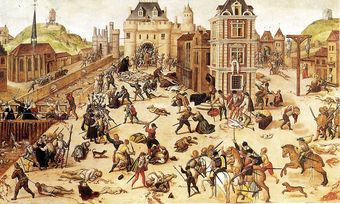
St. Bartholomew Massacre painting by François Dubois, a Huguenot painter
Born circa 1529 in Amiens, Dubois settled in Switzerland. Although Dubois did not witness the massacre, he depicts Admiral Coligny’s body hanging out of a window at the rear to the right. To the left rear, Catherine de’ Medici is shown emerging from the Château du Louvre to inspect a heap of bodies.
War of the Three Henrys
The War of the Three Henrys (1587–1589) was the eighth and final conflict in the series of civil wars in France known as the Wars of Religion. It was a three-way war fought between:
- King Henry III of France, supported by the royalists and the politiques;
- King Henry of Navarre, leader of the Huguenots and heir-presumptive to the French throne, supported by Elizabeth I of England and the Protestant princes of Germany; and
- Henry of Lorraine, Duke of Guise, leader of the Catholic League, funded and supported by Philip II of Spain.
The war began when the Catholic League convinced King Henry III to issue an edict outlawing Protestantism and annulling Henry of Navarre’s right to the throne. For the first part of the war, the royalists and the Catholic League were uneasy allies against their common enemy, the Huguenots. Henry of Navarre sought foreign aid from the German princes and Elizabeth I of England.
Henry III successfully prevented the junction of the German and Swiss armies. The Swiss were his allies, and had come to invade France to free him from subjection, but Henry III insisted that their invasion was not in his favor, but against him, forcing them to return home.
In Paris, the glory of repelling the German and Swiss Protestants all fell to the Duke of Guise. The king’s actions were viewed with contempt. People thought that the king had invited the Swiss to invade, paid them for coming, and sent them back again. The king, who had really performed the decisive part in the campaign, and expected to be honored for it, was astounded that public voice should thus declare against him. The Catholic League had put its preachers to good use.
Open war erupted between the royalists and the Catholic League. Charles, Duke of Mayenne, Guise’s younger brother, took over the leadership of the league. At the moment it seemed that he could not possibly resist his enemies. His power was effectively limited to Blois, Tours, and the surrounding districts. In these dark times the King of France finally reached out to his cousin and heir, the King of Navarre. Henry III declared that he would no longer allow Protestants to be called heretics, while the Protestants revived the strict principles of royalty and divine right. As on the other side ultra-Catholic and anti-royalist doctrines were closely associated, so on the side of the two kings the principles of tolerance and royalism were united.
In July 1589, in the royal camp at Saint-Cloud, a Dominican monk named Jacques Clément gained an audience with the King and drove a long knife into his spleen. Clément was killed on the spot, taking with him the information of who, if anyone, had hired him. On his deathbed, Henri III called for Henry of Navarre, and begged him, in the name of statecraft, to become a Catholic, citing the brutal warfare that would ensue if he refused. He named Henry Navarre as his heir, who became Henry IV.
Edict of Nantes
Fighting continued between Henry IV and the Catholic League for almost a decade. The warfare was finally quelled in 1598 when Henry IV recanted Protestantism in favor of Roman Catholicism, issued as the Edict of Nantes. The edict established Catholicism as the state religion of France, but granted the Protestants equality with Catholics under the throne and a degree of religious and political freedom within their domains. The edict simultaneously protected Catholic interests by discouraging the founding of new Protestant churches in Catholic-controlled regions. With the proclamation of the Edict of Nantes, and the subsequent protection of Huguenot rights, pressures to leave France abated.
In offering general freedom of conscience to individuals, the edict gave many specific concessions to the Protestants, such as amnesty and the reinstatement of their civil rights, including the right to work in any field or for the state and to bring grievances directly to the king. This marked the end of the religious wars that had afflicted France during the second half of the 16th century.
20.1.7: The Witch Trials
Between the 15th and 18th centuries in Europe, many people were accused of and put on trial for practicing witchcraft.
Learning Objective
Demonstrate how natural events and pandemics contributed to the hysteria surrounding the witch trials of the 16th through 18th centuries
Key Points
- In early modern Europe, there was widespread hysteria that malevolent Satanic witches were operating as an organized threat to Christianity. Those who were accused of witchcraft were portrayed as being Devil worshipers.
- In medieval Europe, the Black Death was a turning point in peoples’ views of witches. The death of a large percentage of the European population was believed by many Christians to have been caused by their enemies.
- The peak of the witch hunt was during the European wars of religion, peaking between about 1580 and 1630.
- Over the entire duration of the trials, which spanned three centuries, an estimated total of 40,000–100,000 people were executed.
- The Witch Trials of Trier in Germany was perhaps the biggest witch trial in European history. It led to the death of about 386 people, and was perhaps the biggest mass execution in Europe during peacetime.
- While the witch trials had begun to fade out across much of Europe by the mid-17th century, they became more prominent in the American colonies.
- An estimated 75% to 85% of those accused in the early modern witch trials were women, and there is certainly evidence of misogyny on the part of those persecuting witches.
Key Term
- Johannes Kepler
-
A German mathematician, astronomer, astrologer, and key figure in the 17th century scientific revolution.
The witch trials in the early modern period were a series of witch hunts between the 15th and 18th centuries, when across early modern Europe, and to some extent in the European colonies in North America, there was a widespread hysteria that malevolent Satanic witches were operating as an organized threat to Christendom. Those accused of witchcraft were portrayed as being worshippers of the Devil, who engaged in sorcery at meetings known as Witches’ Sabbaths. Many people were subsequently accused of being witches and were put on trial for the crime, with varying punishments being applicable in different regions and at different times.
In early modern European tradition, witches were stereotypically, though not exclusively, women. European pagan belief in witchcraft was associated with the goddess Diana and dismissed as “diabolical fantasies” by medieval Christian authors.
Background to the Witch Trials
During the medieval period, there was widespread belief in magic across Christian Europe. The medieval Roman Catholic Church, which then dominated a large swath of the continent, divided magic into two forms—natural magic, which was acceptable because it was viewed as merely taking note of the powers in nature that were created by God, and demonic magic, which was frowned upon and associated with demonology.
It was also during the medieval period that the concept of Satan, the Biblical Devil, began to develop into a more threatening form. Around the year 1000, when there were increasing fears that the end of the world would soon come in Christendom, the idea of the Devil had become prominent.
In the 14th and 15th centuries, the concept of the witch in Christendom underwent a relatively radical change. No longer were witches viewed as sorcerers who had been deceived by the Devil into practicing magic that went against the powers of God. Instead they became all-out malevolent Devil-worshippers, who had made pacts with him in which they had to renounce Christianity and devote themselves to Satanism. As a part of this, it was believed that they gained new, supernatural powers that enabled them to work magic, which they would use against Christians.
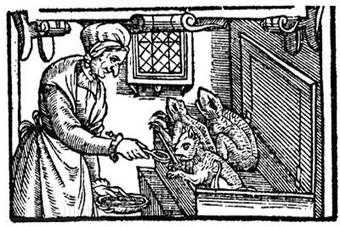
A Witch feeding her familiars
An image of a witch and her familiar spirits taken from a publication that dealt with the witch trials of Elizabeth Stile, Mother Dutten, Mother Devell, and Mother Margaret in Windsor, 1579.
While the witch trials only really began in the 15th century, with the start of the early modern period, many of their causes had been developing during the previous centuries, with the persecution of heresy by the medieval Inquisition during the late 12th and the 13th centuries, and during the late medieval period, during which the idea of witchcraft or sorcery gradually changed and adapted. An important turning point was the Black Death of 1348–1350, which killed a large percentage of the European population, and which many Christians believed had been caused by evil forces.
Beginnings of the Witch Trials
While the idea of witchcraft began to mingle with the persecution of heretics even in the 14th century, the beginning of the witch hunts as a phenomenon in its own right became apparent during the first half of the 15th century in southeastern France and western Switzerland, in communities of the Western Alps, in what was at the time Burgundy and Savoy.
Here, the cause of eliminating the supposed Satanic witches from society was taken up by a number of individuals; Claude Tholosan for instance had tried over two hundred people, accusing them of witchcraft in Briançon, Dauphiné, by 1420.
While early trials fall still within the late medieval period, the peak of the witch hunt was during the period of the European wars of religion, between about 1580 and 1630. Over the entire duration of the phenomenon of some three centuries, an estimated total of 40,000 to 100,000 people were executed.
The Trials of 1580–1630
The height of the European witch trials was between 1560 and 1630, with the large hunts first beginning in 1609. During this period, the biggest witch trials were held in Europe, notably the Trier witch trials (1581–1593), the Fulda witch trials (1603–1606), the Basque witch trials (1609–1611), the Würzburg witch trial (1626–1631), and the Bamberg witch trials (1626–1631).
The Witch Trials of Trier in Germany was perhaps the biggest witch trial in European history. The persecutions started in the diocese of Trier in 1581 and reached the city itself in 1587, where they were to lead to the deaths of about 368 people, and as such it was perhaps the biggest mass execution in Europe during peacetime.
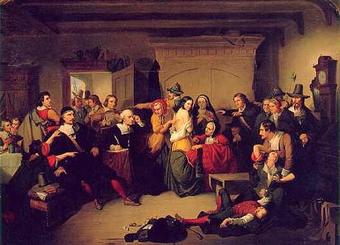
The Examination of a Witch by Matteson
1853 painting by Thompkins H. Matteson, American painter.
In Denmark, the burning of witches increased following the reformation of 1536. Christian IV of Denmark, in particular, encouraged this practice, and hundreds of people were convicted of witchcraft and burned. In England, the Witchcraft Act of 1542 regulated the penalties for witchcraft. In the North Berwick witch trials in Scotland, over seventy people were accused of witchcraft on account of bad weather when James VI of Scotland, who shared the Danish king’s interest in witch trials, sailed to Denmark in 1590 to meet his betrothed, Anne of Denmark.
The sentence for an individual found guilty of witchcraft or sorcery during this time, and in previous centuries, typically included either burning at the stake or being tested with the “ordeal of cold water” or judicium aquae frigidae. Accused persons who drowned were considered innocent, and ecclesiastical authorities would proclaim them “brought back,” but those who floated were considered guilty of practicing witchcraft, and burned at the stake or executed in an unholy fashion.
Decline of the Trials
While the witch trials had begun to fade out across much of Europe by the mid-17th century, they continued to a greater extent on the fringes of Europe and in the American colonies. The clergy and intellectuals began to speak out against the trials from the late 16th century. Johannes Kepler in 1615 could only by the weight of his prestige keep his mother from being burned as a witch. The 1692 Salem witch trials were a brief outburst of witch hysteria in the New World at a time when the practice was already waning in Europe.
Witch Trials and Women
An estimated 75% to 85% of those accused in the early modern witch trials were women, and there is certainly evidence of misogyny on the part of those persecuting witches, evident from quotes such as “[It is] not unreasonable that this scum of humanity, [witches], should be drawn chiefly from the feminine sex” (Nicholas Rémy, c. 1595) or “The Devil uses them so, because he knows that women love carnal pleasures, and he means to bind them to his allegiance by such agreeable provocations.” In early modern Europe, it was widely believed that women were less intelligent than men and more susceptible to sin.
Nevertheless, it has been argued that the supposedly misogynistic agenda of works on witchcraft has been greatly exaggerated, based on the selective repetition of a few relevant passages of the Malleus Maleficarum. Many modern scholars argue that the witch hunts cannot be explained simplistically as an expression of male misogyny, as indeed women were frequently accused by other women, to the point that witch hunts, at least at the local level of villages, have been described as having been driven primarily by “women’s quarrels.” Especially at the margins of Europe, in Iceland, Finland, Estonia, and Russia, the majority of those accused were male.
Barstow (1994) claimed that a combination of factors, including the greater value placed on men as workers in the increasingly wage-oriented economy, and a greater fear of women as inherently evil, loaded the scales against women, even when the charges against them were identical to those against men. Thurston (2001) saw this as a part of the general misogyny of the late medieval and early modern periods, which had increased during what he described as “the persecuting culture” from what it had been in the early medieval period. Gunnar Heinsohn and Otto Steiger in a 1982 publication speculated that witch hunts targeted women skilled in midwifery specifically in an attempt to extinguish knowledge about birth control and “repopulate Europe” after the population catastrophe of the Black Death.
20.2: The Thirty Years’ War
20.2.1: Religious Divide in the Holy Roman Empire
The Thirty Years’ War was a series of wars between various Protestant and Catholic states in the fragmented Holy Roman Empire between 1618 and 1648.
Learning Objective
Understand the origins of the Thirty Years’ War
Key Points
- The Holy Roman Empire was a fragmented collection of largely independent states, which, after the Protestant Reformation in the 16th century, was divided between Catholic and Protestant rulership.
- The Peace of Augsburg ended early conflict between German Lutherans and Catholics and established a principle in which princes were guaranteed the right to select either Lutheranism or Catholicism within the domains they controlled.
- Although the Peace of Augsburg created a temporary end to hostilities, it did not resolve the underlying religious conflict, which was made yet more complex by the spread of Calvinism throughout Germany in the years that followed.
- The war began when the newly elected Holy Roman Emperor, Ferdinand II, tried to impose religious uniformity on his domains, forcing Roman Catholicism on its peoples, and the Protestant states banded together to revolt against him.
Key Terms
- Ferdinand II
-
His rule coincided with the Thirty Years’ War and his aim, as a zealous Catholic, was to restore Catholicism as the only religion in the empire and suppress Protestantism.
- Peace of Augsburg
-
A treaty between Charles V and the forces of Lutheran princes on September 25, 1555, which officially ended the religious struggle between the two groups and allowed princes in the Holy Roman Empire to choose which religion would reign in their principality.
Overview
The Thirty Years’ War was a series of wars in Central Europe between 1618 and 1648. It was one of the longest and most destructive conflicts in European history, resulting in millions of casualties.
Initially a war between various Protestant and Catholic states in the fragmented Holy Roman Empire, it gradually developed into a more general conflict involving most of the great powers. These states employed relatively large mercenary armies, and the war became less about religion and more of a continuation of the France-Habsburg rivalry for European political pre-eminence. In the 17th century, religious beliefs and practices were a much larger influence on an average European. In that era, almost everyone was vested on one side of the dispute or another.
The war began when the newly elected Holy Roman Emperor, Ferdinand II, tried to impose religious uniformity on his domains, forcing Roman Catholicism on its peoples. The northern Protestant states, angered by the violation of their rights to choose granted in the Peace of Augsburg, banded together to form the Protestant Union. Ferdinand II was a devout Roman Catholic and relatively intolerant when compared to his predecessor, Rudolf II. His policies were considered heavily pro-Catholic.
The Holy Roman Empire
The Holy Roman Empire was a fragmented collection of largely independent states. The position of the Holy Roman Emperor was mainly titular, but the emperors, from the House of Habsburg, also directly ruled a large portion of imperial territory (lands of the Archduchy of Austria and the Kingdom of Bohemia), as well as the Kingdom of Hungary. The Austrian domain was thus a major European power in its own right, ruling over some eight million subjects. Another branch of the House of Habsburg ruled over Spain and its empire, which included the Spanish Netherlands, southern Italy, the Philippines, and most of the Americas. In addition to Habsburg lands, the Holy Roman Empire contained several regional powers, such as the Duchy of Bavaria, the Electorate of Saxony, the Margraviate of Brandenburg, the Electorate of the Palatinate, Landgraviate of Hesse, the Archbishopric of Trier, and the Free Imperial City of Nuremberg.
Peace of Augsburg
After the Protestant Reformation, these independent states became divided between Catholic and Protestant rulership, giving rise to conflict. The Peace of Augsburg (1555), signed by Charles V, Holy Roman Emperor, ended the war between German Lutherans and Catholics. The Peace established the principle Cuius regio, eius religio (“Whose realm, his religion”), which allowed Holy Roman Empire state princes to select either Lutheranism or Catholicism within the domains they controlled, ultimately reaffirming the independence they had over their states. Subjects, citizens, or residents who did not wish to conform to a prince’s choice were given a period in which they were free to emigrate to different regions in which their desired religion had been accepted.
Although the Peace of Augsburg created a temporary end to hostilities, it did not resolve the underlying religious conflict, which was made yet more complex by the spread of Calvinism throughout Germany in the years that followed. This added a third major faith to the region, but its position was not recognized in any way by the Augsburg terms, to which only Catholicism and Lutheranism were parties.
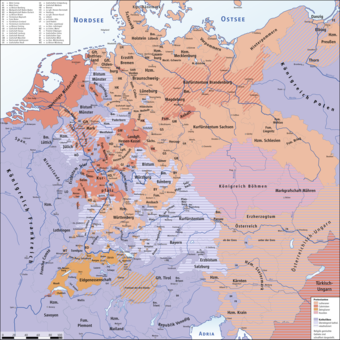
Religion in the Holy Roman Empire, 1618
Religion in the Holy Roman Empire on the eve of the Thirty Years’ War. Blues indicate Catholic regions and red/orange indicate Protestant (including Lutheran, Calvinist, Hussite, and Reform).
Tension Mount
Religious tensions remained strong throughout the second half of the 16th century. The Peace of Augsburg began to unravel—some converted bishops refused to give up their bishoprics, and certain Habsburg and other Catholic rulers of the Holy Roman Empire and Spain sought to restore the power of Catholicism in the region. This was evident from the Cologne War (1583–1588), in which a conflict ensued when the prince-archbishop of the city, Gebhard Truchsess von Waldburg, converted to Calvinism. As he was an imperial elector, this could have produced a Protestant majority in the college that elected the Holy Roman Emperor, a position that Catholics had always held.
At the beginning of the 17th century, the Rhine lands and those south to the Danube were largely Catholic, while the north was dominated by Lutherans, and certain other areas, such as west-central Germany, Switzerland, and the Netherlands, were dominated by Calvins. Minorities of each creed existed almost everywhere, however. In some lordships and cities, the numbers of Calvinists, Catholics, and Lutherans were approximately equal.
Much to the consternation of their Spanish ruling cousins, the Habsburg emperors who followed Charles V (especially Ferdinand I and Maximilian II, but also Rudolf II and his successor, Matthias) were content to allow the princes of the empire to choose their own religious policies. These rulers avoided religious wars within the empire by allowing the different Christian faiths to spread without coercion. This angered those who sought religious uniformity. Meanwhile, Sweden and Denmark, both Lutheran kingdoms, sought to assist the Protestant cause in the Empire, and wanted to gain political and economic influence there as well.
By 1617, it was apparent that Matthias, Holy Roman Emperor and King of Bohemia, would die without an heir, with his lands going to his nearest male relative, his cousin Archduke Ferdinand II of Austria, heir-apparent and Crown Prince of Bohemia.
War Breaks Out
Ferdinand II, educated by the Jesuits, was a staunch Catholic who wanted to impose religious uniformity on his lands. This made him highly unpopular in Protestant Bohemia. The population’s sentiments notwithstanding, the added insult of the nobility’s rejection of Ferdinand, who had been elected Bohemian Crown Prince in 1617, triggered the Thirty Years’ War in 1618, when his representatives were thrown out of a window and seriously injured. The so-called Defenestration of Prague provoked open revolt in Bohemia, which had powerful foreign allies. Ferdinand was upset by this calculated insult, but his intolerant policies in his own lands had left him in a weak position. The Habsburg cause in the next few years would seem to suffer unrecoverable reverses. The Protestant cause seemed to wax toward a quick overall victory.
The war can be divided into four major phases: The Bohemian Revolt, the Danish intervention, the Swedish intervention, and the French intervention.
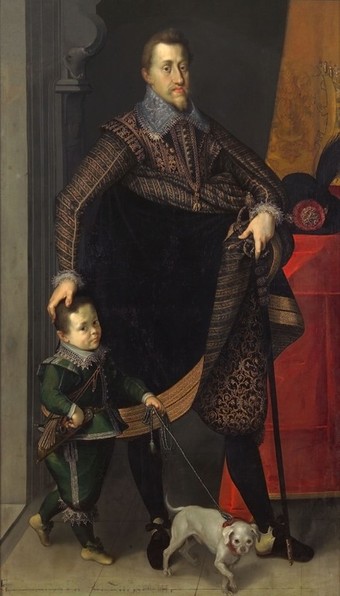
Ferdinand II
Ferdinand II, Holy Roman Emperor and King of Bohemia, whose aim, as a zealous Catholic, was to restore Catholicism as the only religion in the empire and suppress Protestantism, and whose actions helped precipitate the Thirty Years’ War.
20.2.2: Bohemian Period
The Bohemian Revolt (1618–1620) was an uprising of the Bohemian estates against the rule of the Habsburg dynasty, in particular Emperor Ferdinand II, which triggered the Thirty Years’ War.
Learning Objective
Describe the events surrounding the Defenestration of Prague
Key Points
- Since 1526, the Kingdom of Bohemia had been governed by Catholic Habsburg kings who were tolerant of their largely Protestant subjects.
- Toward the end his reign, Emperor Matthias, realizing he would die without an heir, arranged for his lands to go to his nearest male relative, the staunchly Catholic Archduke Ferdinand II of Austria.
- Protestants in Bohemia were wary of Ferdinand reversing the religious tolerance and freedom formerly established by the Peace of Augsburg.
- In 1618, Ferdinand’s royal representatives were thrown out of a window and seriously injured in the so-called Defenestration of Prague, which provoked open Protestant revolt in Bohemia.
- The dispute culminated after several battles in the final Battle of White Mountain, where the Protestants suffered a decisive defeat. This started re-Catholicization of the Czech lands, but also triggered the Thirty Years’ War, which spread to the rest of Europe and devastated vast areas of central Europe, including the Czech lands.
Key Terms
- defenestration
-
The act of throwing someone out of a window.
- Bohemian Revolt
-
An uprising of the Bohemian estates against the rule of the Habsburg dynasty.
Background
In 1555, the Peace of Augsburg had settled religious disputes in the Holy Roman Empire by enshrining the principle of Cuius regio, eius religio, allowing a prince to determine the religion of his subjects. Since 1526, the Kingdom of Bohemia had been governed by Habsburg kings who did not force their Catholic religion on their largely Protestant subjects. In 1609, Rudolf II, Holy Roman Emperor and King of Bohemia (1576–1612), increased Protestant rights. He was increasingly viewed as unfit to govern, and other members of the Habsburg dynasty declared his younger brother, Matthias, to be family head in 1606. Upon Rudolf’s death, Matthias succeeded in the rule of Bohemia.
Without heirs, Emperor Matthias sought to assure an orderly transition during his lifetime by having his dynastic heir (the fiercely Catholic Ferdinand of Styria, later Ferdinand II, Holy Roman Emperor) elected to the separate royal thrones of Bohemia and Hungary. Ferdinand was a proponent of the Catholic Counter-Reformation, and not well-disposed to Protestantism or Bohemian freedoms. Some of the Protestant leaders of Bohemia feared they would be losing the religious rights granted to them by Emperor Rudolf II in his Letter of Majesty (1609). They preferred the Protestant Frederick V, Elector of the Palatinate (successor of Frederick IV, the creator of the Protestant Union). However, other Protestants supported the stance taken by the Catholics, and in 1617 Ferdinand was duly elected by the Bohemian Estates to become the Crown Prince and, automatically upon the death of Matthias, the next King of Bohemia.
The Defenestration of Prague
The king-elect then sent two Catholic councillors (Vilem Slavata of Chlum and Jaroslav Borzita of Martinice) as his representatives to Hradčany castle in Prague in May 1618. Ferdinand had wanted them to administer the government in his absence. On May 23, 1618, an assembly of Protestants seized them and threw them (and also secretary Philip Fabricius) out of the palace window, which was some sixty-nine feet off the ground. Remarkably, though injured, they survived. This event, known as the Defenestration of Prague, started the Bohemian Revolt. Soon afterward, the Bohemian conflict spread through all of the Bohemian Crown, including Bohemia, Silesia, Upper and Lower Lusatia, and Moravia. Moravia was already embroiled in a conflict between Catholics and Protestants. The religious conflict eventually spread across the whole continent of Europe, involving France, Sweden, and a number of other countries.
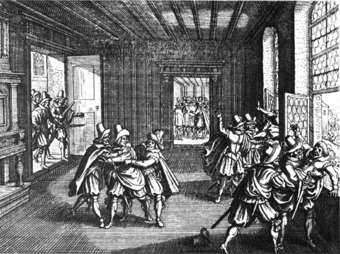
Defenestration of Prague
A later woodcut of the Defenestration of Prague in 1618, which triggered the Thirty Years’ War.
Aftermath
Immediately after the defenestration, the Protestant estates and Catholic Habsburgs started gathering allies for war. After the death of Matthias in 1619, Ferdinand II was elected Holy Roman Emperor. At the same time, the Bohemian estates deposed Ferdinand as King of Bohemia (Ferdinand remained emperor, since the titles are separate) and replaced him with Frederick V, Elector Palatine, a leading Calvinist and son-in-law of the Protestant James VI and I, King of Scotland, England, and Ireland.
Because they deposed a properly chosen king, the Protestants could not gather the international support they needed for war. Just two years after the Defenestration of Prague, Ferdinand and the Catholics regained power in the Battle of White Mountain on November 8, 1620. This became known as the first battle in the Thirty Years’ War.
This was a serious blow to Protestant ambitions in the region. As the rebellion collapsed, the widespread confiscation of property and suppression of the Bohemian nobility ensured the country would return to the Catholic side after more than two centuries of Protestant dissent.
There was plundering and pillaging in Prague for weeks following the battle. Several months later, twenty-seven nobles and citizens were tortured and executed in the Old Town Square. Twelve of their heads were impaled on iron hooks and hung from the Bridge Tower as a warning. This also contributed to catalyzing the Thirty Years’ War.
20.2.3: Danish Intervention
After the Bohemian Revolt was suppressed by Ferdinand II, the Danish king, Christian IV, fearing that recent Catholic successes threatened his sovereignty as a Protestant nation, led troops against Ferdinand.
Learning Objective
Analyze the reasons for Denmark getting involved in the war
Key Points
- After the Defenestration of Prague and the ensuing Bohemian Revolt, the Protestants warred with the Catholic League until the former were firmly defeated at the Battle of Stadtlohn in 1623.
- With news of the outcome reaching Frederick V of the Palatinate, the king was forced to sign an armistice with Holy Roman Emperor Ferdinand II, thus ending the “Palatine Phase” of the Thirty Years’ War.
- Peace was short lived; the Danish duchy, under the rule of Christian IV, rallied troops to support the Protestants against Ferdinand.
- Ferdinand received support from Albrecht von Wallenstein, who led troops to defeat Christian IV’s army.
- With another military success for the Catholics, Ferdinand II took back several Protestant holdings and declared the Edict of Restitution in an attempt to restore the religious and territorial situations reached in the Peace of Augsburg.
Key Term
- Edict of Restitution
-
Oassed eleven years into the Thirty Years’ War, this edict was a belated attempt by Ferdinand II to impose and restore the religious and territorial situations reached in the Peace of Augsburg (1555).
Background
After the Defenestration of Prague and the ensuing Bohemian Revolt, the Protestants warred with the Catholic League until the former were firmly defeated at the Battle of Stadtlohn in 1623. After this catastrophe, Frederick V, already in exile in The Hague, and under growing pressure from his father-in-law, James I, to end his involvement in the war, was forced to abandon any hope of launching further campaigns. The Protestant rebellion had been crushed. Frederick was forced to sign an armistice with Holy Roman Emperor Ferdinand II, thus ending the “Palatine Phase” of the Thirty Years’ War.
Dutch Intervention
Peace following the imperial victory at Stadtlohn proved short lived, with conflict resuming at the initiation of Denmark. Danish involvement, referred to as the Low Saxon War, began when Christian IV of Denmark, a Lutheran who also ruled as Duke of Holstein, a duchy within the Holy Roman Empire, helped the Lutheran rulers of neighboring Lower Saxony by leading an army against Ferdinand II’s imperial forces in 1625. Denmark had feared that the recent Catholic successes threatened its sovereignty as a Protestant nation.
Christian IV had profited greatly from his policies in northern Germany. For instance, in 1621, Hamburg had been forced to accept Danish sovereignty. Denmark’s King Christian IV had obtained for his kingdom a level of stability and wealth that was virtually unmatched elsewhere in Europe. Denmark was funded by tolls on the Oresund and also by extensive war reparations from Sweden.
Denmark’s cause was aided by France, which together with Charles I had agreed to help subsidize the war, not the least because Christian was a blood uncle to both the Stuart king and his sister Elizabeth of Bohemia through their mother, Anne of Denmark. Some 13,700 Scottish soldiers under the command of General Robert Maxwell, 1st Earl of Nithsdale, were sent as allies to help Christian IV. Moreover, some 6,000 English troops under Charles Morgan also eventually arrived to bolster the defense of Denmark, though it took longer for them to arrive than Christian had hoped, due partially to the ongoing British campaigns against France and Spain. Thus, Christian, as war-leader of the Lower Saxon Circle, entered the war with an army of only 20,000 mercenaries, some of his allies from England and Scotland, and a national army 15,000 strong, leading them as Duke of Holstein rather than as King of Denmark.
War Ensues
To fight Christian, Ferdinand II employed the military help of Albrecht von Wallenstein, a Bohemian nobleman who had made himself rich from the confiscated estates of his Protestant countrymen. Wallenstein pledged his army, which numbered between 30,000 and 100,000 soldiers, to Ferdinand II in return for the right to plunder the captured territories. Christian, who knew nothing of Wallenstein’s forces when he invaded, was forced to retire before the combined forces of Wallenstein and Tilly. Christian’s mishaps continued when all of the allies he thought he had were forced aside: France was in the midst of a civil war, Sweden was at war with the Polish–Lithuanian Commonwealth, and neither Brandenburg nor Saxony was interested in changes to the tenuous peace in eastern Germany. Moreover, neither of the substantial British contingents arrived in time to prevent Wallenstein’s defeat of Mansfeld’s army at the Battle of Dessau Bridge (1626) or Tilly’s victory at the Battle of Lutter (1626). Mansfeld died some months later of illness, apparently tuberculosis, in Dalmatia.
Wallenstein’s army marched north, occupying Mecklenburg, Pomerania, and Jutland itself, but proved unable to take the Danish capital, Copenhagen, on the island of Zealand. Wallenstein lacked a fleet, and neither the Hanseatic ports nor the Poles would allow the building of an imperial fleet on the Baltic coast. He then laid siege to Stralsund, the only belligerent Baltic port with sufficient facilities to build a large fleet; it soon became clear, however, that the cost of continuing the war would far outweigh any gains from conquering the rest of Denmark. Wallenstein feared losing his northern German gains to a Danish-Swedish alliance, while Christian IV had suffered another defeat in the Battle of Wolgast (1628); both were ready to negotiate.
Negotiations and the Edict of Restitution
Negotiations concluded with the Treaty of Lübeck in 1629, which stated that Christian IV could retain control over Denmark (including the duchies of Sleswick and Holstein) if he would abandon his support for the Protestant German states. Thus, in the following two years, the Catholic powers subjugated more land. At this point, the Catholic League persuaded Ferdinand II to take back the Lutheran holdings that were, according to the Peace of Augsburg, rightfully the possession of the Catholic Church. Enumerated in the Edict of Restitution (1629), these possessions included two archbishoprics, sixteen bishoprics, and hundreds of monasteries. In the same year, Gabriel Bethlen, the Calvinist prince of Transylvania, died. Only the port of Stralsund continued to hold out against Wallenstein and the emperor, having been bolstered by Scottish “volunteers” who arrived from the Swedish army to support their countrymen already there in the service of Denmark.
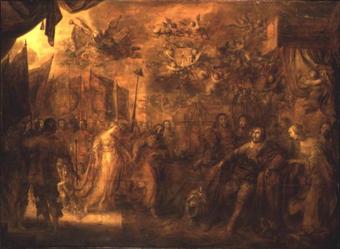
Christian IV of Denmark
Christian IV receives homage from the countries of Europe as mediator in the Thirty Years’ War. Painting by Grisaille by Adrian van de Venne, 1643.
20.2.4: Swedish Intervention
The Swedish intervention in the Thirty Years’ War, when King Gustav II Adolf of Sweden ordered a full-scale invasion of the Catholic states, was a major turning point of the war.
Learning Objective
Discuss why the Swedish were inclined to join in the war
Key Points
- The Swedish intervention in the Thirty Years’ War, which took place between 1630 and 1635, was a major turning point of the war, often considered to be an independent conflict.
- The king of Sweden, Gustav Adolph, had been well informed of the war between the Catholics and Protestants in the Holy Roman Empire for some time, but did not get involved because of an ongoing conflict with Poland.
- While Sweden was under a truce with Poland, Gustav reformed the Swedish military, leading to an army that became the model for all of Europe.
- From 1630 to 1634, Swedish-led armies drove the Catholic forces back, regaining much of the lost Protestant territory, especially at the key Battle of Breitenfeld.
- By the spring of 1635, the Catholic and the Protestant sides met for negotiations, producing the Peace of Prague (1635), which entailed a delay in the enforcement of the Edict of Restitution for forty years.
Key Terms
- Gustavus Adolphus
-
The king of Sweden from 1611 to 1632, credited with founding the Swedish Empire, who led Sweden to military supremacy during the Thirty Years’ War.
- Pomerania
-
A region on the southern shore of the Baltic Sea in Central Europe, split between Germany and Poland.
Overview
The Swedish intervention in the Thirty Years’ War, which took place between 1630 and 1635, was a major turning point of the war, often considered to be an independent conflict. After several attempts by the Holy Roman Empire to prevent the spread of Protestantism in Europe, King Gustav II Adolf of Sweden ordered a full-scale invasion of the Catholic states. Although he was killed in action, his armies successfully defeated their enemies and gave birth to the Swedish Empire after proving their ability in combat. The new European power would last for a hundred years before being overwhelmed by numerous enemies in the Great Northern War.
Background
The king of Sweden, Gustav II Adolph, had been well informed of the war between the Catholics and Protestants in the Holy Roman Empire for some time, but his hands were tied because of the constant enmity of Poland. The Polish royal family, the primary branch of the House of Vasa, had once claimed the throne of Sweden.
Lutheranism was the primary religion of Sweden, and had by then established a firm grip on the country, but it was not solely the result of religious sentiment that Sweden converted. Notably, one of the reasons that Sweden had so readily embraced it was because converting to Lutheranism allowed the crown to seize all the lands in Sweden that were possessed by the Roman Catholic Church. As a result of this seizure and the money that the crown gained, the crown was greatly empowered.
Gustav was concerned about the growing power of the Holy Roman Empire, and like Christian IV before him, was heavily subsidized by Cardinal Richelieu, the chief minister of Louis XIII of France, and by the Dutch.
Sweden’s Army
During this time, and while Sweden was under a truce with Poland, Gustav established a military system that was to become the envy of Europe. He drew up a new military code. The new improvements to Sweden’s military order even pervaded the state by fueling fundamental changes in the economy. The military reforms—among which tight discipline was one of the prevailing principles—brought the Swedish military to the highest levels of military readiness and were to become the standard that European states would strive for.
The severity of discipline was not the only change that took place in the army. Soldiers were to be rewarded for meritorious service. Soldiers who had displayed courage and distinguished themselves in the line of duty were paid generously, in addition to being given pensions. The corp of engineers were the most modern of their age, and in the campaigns in Germany the population repeatedly expressed surprise at the extensive nature of the entrenchment and the elaborate nature of the equipment.
Swedish Intervention
From 1630 to 1634, Swedish-led armies drove the Catholic forces back, regaining much of the lost Protestant territory. During the campaign, Sweden managed to conquer half of the imperial kingdoms, making it the continental leader of Protestantism until the Swedish Empire ended in 1721.
Swedish forces entered the Holy Roman Empire via the Duchy of Pomerania, which had served as the Swedish bridgehead since the Treaty of Stettin (1630). After dismissing Wallenstein in 1630, from fear he was planning a revolt, Ferdinand II became dependent on the Catholic League. Gustavus Adolphus allied with France and Bavaria.
At the Battle of Breitenfeld (1631), Gustavus Adolphus’s forces defeated the Catholic League led by Tilly. A year later, they met again in another Protestant victory, this time accompanied by the death of Tilly. The upper hand had now switched from the Catholic League to the Protestant Union, led by Sweden.
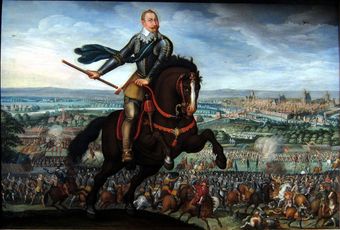
King Gustav of Sweden
The victory of Gustavus Adolphus at the Battle of Breitenfeld (1631).
With Tilly dead, Ferdinand II returned to the aid of Wallenstein and his large army. Wallenstein marched to the south, threatening Gustavus Adolphus’s supply chain. Gustavus Adolphus knew that Wallenstein was waiting for the attack and was prepared, but found no other option. Wallenstein and Gustavus Adolphus clashed in the Battle of Lützen (1632), where the Swedes prevailed, but Gustavus Adolphus was killed.
Ferdinand II’s suspicion of Wallenstein resumed in 1633, when Wallenstein attempted to arbitrate the differences between the Catholic and Protestant sides. Ferdinand II may have feared that Wallenstein would switch sides, and arranged for his arrest after removing him from command. One of Wallenstein’s soldiers, Captain Devereux, killed him when he attempted to contact the Swedes in the town hall of Eger (Cheb) on February 25, 1634. The same year, the Protestant forces, lacking Gustav’s leadership, were smashed at the First Battle of Nördlingen by the Spanish-Imperial forces commanded by Cardinal-Infante Ferdinand.
Peace of Prague
By the spring of 1635, all Swedish resistance in the south of Germany had ended. After that, the imperialist and the Protestant German sides met for negotiations, producing the Peace of Prague (1635), which entailed a delay in the enforcement of the Edict of Restitution for forty years and allowed Protestant rulers to retain secularized bishoprics held by them in 1627. This protected the Lutheran rulers of northeastern Germany, but not those of the south and west. Initially after the Peace of Prague, the Swedish armies were pushed back by the reinforced imperial army north into Germany.
The treaty also provided for the union of the army of the emperor and the armies of the German states into a single army of the Holy Roman Empire. Finally, German princes were forbidden from establishing alliances amongst themselves or with foreign powers, and amnesty was granted to any ruler who had taken up arms against the emperor after the arrival of the Swedes in 1630.
This treaty failed to satisfy France, however, because of the renewed strength it granted the Habsburgs. France then entered the conflict, beginning the final period of the Thirty Years’ War. Sweden did not take part in the Peace of Prague, and it joined with France in continuing the war.
20.2.5: Swedish-French Intervention
No longer able to tolerate the encirclement of two major Habsburg powers on its borders, Catholic France entered the Thirty Years’ War on the side of the Protestants to counter the Habsburgs and bring the war to an end.
Learning Objective
Identify the reasons why France was invested in the events of the Thirty Years’ War
Key Points
- France, though Roman Catholic, was a rival of the Holy Roman Empire and Spain because they considered the Habsburgs too powerful since they held a number of territories on France’s eastern border.
- Cardinal Richelieu, the chief minister of King Louis XIII of France, made the decision to enter into direct war against the Habsburgs in 1634, but France suffered military defeats early on, losing territory to the Holy Roman Empire.
- The tide of the war turned clearly toward France and against Spain in 1640, starting with the siege and capture of the fort at Arras.
- After the Peace of Prague, the Swedes reorganized the Royal Army and reentered the war, winning important battles against the imperial army.
- In 1648, the Swedes and the French defeated the imperial army at the Battle of Zusmarshausen, and the Spanish at Lens, and later won the Battle of Prague, which became the last action of the Thirty Years’ War.
Key Terms
- Vulgate Bible
-
A late 4th century Latin translation of the Bible that became, during the 16th century, the Catholic church’s officially promulgated Latin version of the Bible.
- Gustavus Adolphus
-
The king of Sweden from 1611 to 1632, who led Sweden to military supremacy during the Thirty Years’ War, helping to determine the political as well as the religious balance of power in Europe.
France’s Opposition to the Holy Roman Empire
France, though Roman Catholic, was a rival of the Holy Roman Empire and Spain. Cardinal Richelieu, the chief minister of King Louis XIII of France, considered the Habsburgs too powerful because they held a number of territories on France’s eastern border, including portions of the Netherlands. Richelieu had already begun intervening indirectly in the war in January 1631, when the French diplomat Hercule de Charnacé signed the Treaty of Bärwalde with Gustavus Adolphus, by which France agreed to support the Swedes with 1,000,000 livres each year in return for a Swedish promise to maintain an army in Germany against the Habsburgs. The treaty also stipulated that Sweden would not conclude a peace with the Holy Roman Emperor without first receiving France’s approval.
France Enters the War
After the Swedish rout at Nördlingen in September 1634 and the Peace of Prague in 1635, in which the Protestant German princes sued for peace with the German emperor, Sweden’s ability to continue the war alone appeared doubtful, and Richelieu made the decision to enter into direct war against the Habsburgs. France declared war on Spain in May 1635, and on the Holy Roman Empire in August 1636, opening offensives against the Habsburgs in Germany and the Low Countries. France aligned its strategy with the allied Swedes in Wismar (1636) and Hamburg (1638).
Early French military efforts were met with disaster, and the Spanish counter-attacked, invading French territory. The imperial general Johann von Werth and Spanish commander Cardinal-Infante Ferdinand ravaged the French provinces of Champagne, Burgundy, and Picardy, and even threatened Paris in 1636. Then, the tide began to turn for the French. The Spanish army was repulsed by Bernhard of Saxe-Weimar. Bernhard’s victory in the Battle of Compiègne pushed the Habsburg armies back towards the borders of France. Then widespread fighting ensued until 1640, with neither side gaining an advantage.
However, the war reached a climax and the tide of the war turned clearly toward France and against Spain in 1640, starting with the siege and capture of the fort at Arras. The French conquered Arras from the Spanish following a siege that lasted from June 16 to August 9, 1640. When Arras fell, the way was opened for the French to take all of Flanders. The ensuing French campaign against the Spanish forces in Flanders culminated with a decisive French victory at Rocroi in May 1643.
Continued Swedish War Efforts
After the Peace of Prague, the Swedes reorganized the Royal Army under Johan Banér and created a new one, the Army of the Weser, under the command of Alexander Leslie. The two army groups moved south in the spring of 1636, re-establishing alliances on the way, including a revitalized one with Wilhelm of Hesse-Kassel. The two Swedish armies combined and confronted the imperialists at the Battle of Wittstock. Despite the odds being stacked against them, the Swedish army won. This success largely reversed many of the effects of their defeat at Nördlingen, albeit not without creating some tensions between Banér and Leslie.
After the battle of Wittstock, the Swedish army regained the initiative in the German campaign. In the Second Battle of Breitenfeld, in 1642, outside Leipzig, the Swedish Field Marshal Lennart Torstenson defeated an army of the Holy Roman Empire led by Archduke Leopold Wilhelm of Austria and his deputy, Prince-General Ottavio Piccolomini, Duke of Amalfi. The imperial army suffered 20,000 casualties. In addition, the Swedish army took 5,000 prisoners and seized forty-six guns, at a cost to themselves of 4,000 killed or wounded. The battle enabled Sweden to occupy Saxony and impressed on Ferdinand III the need to include Sweden, and not only France, in any peace negotiations.
Final Battles
Over the next four years, fighting continued, but all sides began to prepare for ending the war. In 1648, the Swedes (commanded by Marshal Carl Gustaf Wrangel) and the French (led by Turenne and Condé) defeated the imperial army at the Battle of Zusmarshausen, and the Spanish at Lens. However, an imperial army led by Octavio Piccolomini managed to check the Franco-Swedish army in Bavaria, though their position remained fragile. The Battle of Prague in 1648 became the last action of the Thirty Years’ War. The general Hans Christoff von Königsmarck, commanding Sweden’s flying column, entered the city and captured Prague Castle (where the event that triggered the war—the Defenestration of Prague—had taken place thirty years before). There, they captured many valuable treasures, including the Codex Gigas, which contains the Vulgate Bible as well as many historical documents all written in Latin, and is still today preserved in Stockholm as the largest extant medieval manuscript in the world. However, they failed to conquer the right-bank part of Prague and the old city, which resisted until the end of the war. These results left only the imperial territories of Austria safely in Habsburg hands.
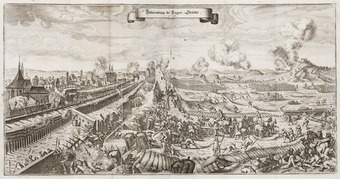
The Swedish siege of Prague in 1648
In 1648, the Swedish army entered Prague and captured Prague Castle, where the catalyst of the war, the Defenestration of Prague, had taken place thirty years before.
20.2.6: The Peace of Westphalia
The Peace of Westphalia was a series of peace treaties signed between May and October 1648 in the Westphalian cities of Osnabrück and Münster that ended the Thirty Years’ War.
Learning Objective
Describe the terms of the Peace of Westphalia
Key Points
- The end of the Thirty Years’ War was not brought about by one treaty, but instead by a group of treaties, collectively named the Peace of Westphalia.
- The treaties did not restore peace throughout Europe, but they did create a basis for national self-determination.
- Along with several territorial adjustments, the terms of the Peace of Westphalia included a return to the principles in the Peace of Augsburg of 1555, in which each prince would have the right to determine the religion of his own state.
- The treaty also extended that tolerance to allow the minority religion of the territory to practice freely.
- The Peace of Westphalia established important political precedents for state sovereignty, inter-state diplomacy, and balance of power in Europe.
Key Terms
- fief
-
An estate of land, especially one held on condition of feudal service.
- letters of marque
-
A government license authorizing a person (known as a privateer) to attack and capture enemy vessels and bring them before admiralty courts for condemnation and sale.
- Imperial Diet
-
The legislative body of the Holy Roman Empire, theoretically superior to the emperor himself.
Overview
Over a four-year period, the warring parties of the Thirty Years’ War (the Holy Roman Empire, France, and Sweden) were actively negotiating at Osnabrück and Münster in Westphalia. The end of the war was not brought about by one treaty, but instead by a group of treaties, collectively named the Peace of Westphalia. The three treaties involved were the Peace of Münster (between the Dutch Republic and the Kingdom of Spain), the Treaty of Münster (between the Holy Roman Emperor and France and their respective allies), and the Treaty of Osnabrück (between the Holy Roman Empire and Sweden and their respective allies).
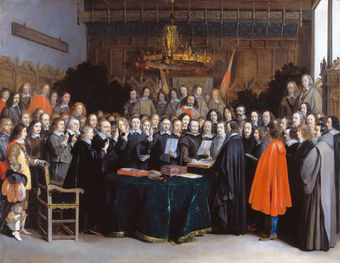
The Ratification of the Treaty of Münster, 1648
The Treaty of Münster between the Holy Roman Emperor and France was one of three treaties that made up the Peace of Westphalia.
These treaties ended both the Thirty Years’ War (1618–1648) in the Holy Roman Empire and the Eighty Years’ War (1568–1648) between Spain and the Dutch Republic, with Spain formally recognizing the independence of the Dutch Republic.
The peace negotiations involved a total of 109 delegations representing European powers, including Holy Roman Emperor Ferdinand III, Philip IV of Spain, the Kingdom of France, the Swedish Empire, the Dutch Republic, the princes of the Holy Roman Empire, and sovereigns of the free imperial cities.
The Terms of the Peace Settlement
Along with ending open warfare between the belligerents, the Peace of Westphalia established several important tenets and agreements:
- The power taken by Ferdinand III in contravention of the Holy Roman Empire’s constitution was stripped and returned to the rulers of the Imperial States.
- All parties would recognize the Peace of Augsburg of 1555, in which each prince would have the right to determine the religion of his own state, the options being Catholicism, Lutheranism, and now Calvinism. This affirmed the principle of cuius regio, eius religio (Whose realm, his religion).
- Christians living in principalities where their denomination was not the established church were guaranteed the right to practice their faith in public during allotted hours and in private at their will.
- General recognition of the exclusive sovereignty of each party over its lands, people, and agents abroad, and responsibility for the warlike acts of any of its citizens or agents. Issuance of unrestricted letters of marque and reprisal to privateers was forbidden.
There were also several territorial adjustments brought about by the peace settlements. For example, the independence of Switzerland from the empire was formally recognized. France came out of the war in a far better position than any of the other participants. France retained the control of the Bishoprics of Metz, Toul, and Verdun near Lorraine, received the cities of the Décapole in Alsace and the city of Pignerol near the Spanish Duchy of Milan. Sweden received Western Pomerania, Wismar, and the Prince-Bishoprics of Bremen and Verden as hereditary fiefs, thus gaining a seat and vote in the Imperial Diet of the Holy Roman Empire. Barriers to trade and commerce erected during the war were also abolished, and a degree of free navigation was guaranteed on the Rhine.
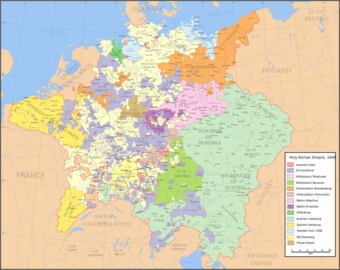
The Holy Roman Empire in 1648
After the Peace of Westphalia, each prince of a given Imperial State would have the right to determine the religion of his own state, the options being Catholicism, Lutheranism, and Calvinism.
Impact and Legacy
The treaty did not entirely end conflicts arising out of the Thirty Years’ War. Fighting continued between France and Spain until the Treaty of the Pyrenees in 1659. Nevertheless, it did settle many outstanding European issues of the time. Some of the principles developed at Westphalia, especially those relating to respecting the boundaries of sovereign states and non-interference in their domestic affairs, became central to the world order that developed over the following centuries, and remain in effect today. Many of the imperial territories established in the Peace of Westphalia later became the sovereign nation-states of modern Europe.
The Peace of Westphalia established the precedent of peaces established by diplomatic congress, and a new system of political order in central Europe, later called Westphalian sovereignty, based upon the concept of co-existing sovereign states. Inter-state aggression was to be held in check by a balance of power. A norm was established against interference in another state’s domestic affairs. As European influence spread across the globe, these Westphalian principles, especially the concept of sovereign states, became central to international law and to the prevailing world order.
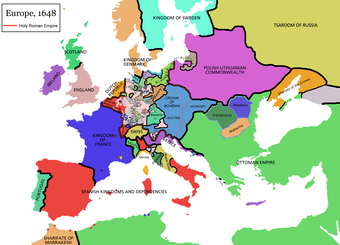
Europe in 1648
A simplified map of Europe in 1648, showing the new borders established after the Peace of Westphalia.
